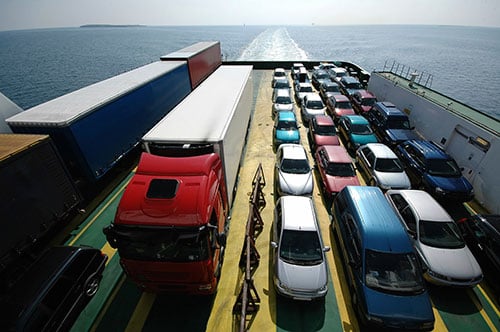
Scott Mabry is a highly respected leader in the logistics industry. He is manager, cross border logistics at Volkswagen Group of America and has held leadership roles at Gedas and Federal Mogul prior to joining Volkswagen since 2008.
 Mabry is a member of the Finished Vehicle Logistics Advisory Group at AIAG and chair of the Connected Vehicle Work Group and the Rail/Haul-Away Work Group. He is a critical asset to AIAG work groups and a professional truly committed to making a positive difference in the industry. In this interview, Mabry weighs in on a variety of topics affecting FVL and supply chain managers.
Mabry is a member of the Finished Vehicle Logistics Advisory Group at AIAG and chair of the Connected Vehicle Work Group and the Rail/Haul-Away Work Group. He is a critical asset to AIAG work groups and a professional truly committed to making a positive difference in the industry. In this interview, Mabry weighs in on a variety of topics affecting FVL and supply chain managers.
Q: What is your background in the finished vehicle logistics industry?
Mabry: I originally came into automotive world in the via the IT side of the business. At Volkswagen, I started as the IT and process consultant for the supply chain group. I’ve rotated through various roles like network planning, parts and vehicle transportation management, and logistics purchasing and had the opportunity to run the European outbound operations for Volkswagen commercial vehicles and lived just outside Hannover, Germany, for a while.
Q: What did your first job in logistics teach you?
Mabry: I learned the ins and out of warehousing when I worked with a parts manufacturer, and we converted a facility from picking order on paper to handheld scanners. I learned that cultural and process changes are tougher than switching technologies. It taught me what it takes to work with different folks through change.
Q: What are your responsibilities in your current role at Volkswagen?
Mabry: In my role as manager of cross border logistics at VWGoA, I work with each of the local sales and logistics teams in Mexico, Canada, the U.S. and with our logistics partners at VW Group in Germany. My role is to ensure the supply chain team works in coordination to get the best results for the group. Together we look at future plans, goals, and where we are going in the technology space.
Q: What’s the difference between logistics and supply chain?
Mabry: The full supply chain is starts with the customer and ends with the customer. Logistics is the magic that takes that order, turns it into a physical product, and delivers it to their door.
Q: Why do you use a third-party logistics provider?
Mabry: OEMs specialize in R&D, manufacturing, and selling the cars. We rely on third-party logistics providers who are specialized and deeply focused on their part of the supply chain to bring us excellence in their processes like we have in our vehicles.
Q: What have been the biggest changes in FVL over the past several years?
Mabry: The instability in the supply chain has really shaken up the normal operating procedures, and all companies have had to reevaluate how to make the best with what they have in their hands to work with either shippable volumes or available capacity.
Q: What recent supply chain development will have the greatest impact on your job?
Mabry: The roll out of telematics across the supply chain and the integration of the connected car.
Q: How will the connected vehicle affect FVL in terms of efficiency and productivity?
Mabry: We will all adjust our processes to the new information the vehicles themselves can give us and gain some efficiencies, but the demand for even more details on tracking the cars for the dealers and end customers will mean we have to add more resources.
Q: What changes would you make to the strategic direction of the FVL industry?
Mabry: I don’t see a clear vision of where we want to be in 5 or 10 years. We are too reactive to current events. Greater focus, more time investment, and faster agreements on process optimization across all groups will help us all. There isn’t as strong of a consolidated voice for finished vehicle logistics coming from the trucking industry as there is for rail and OEMs due to the number of companies involved.
Q: What are the biggest obstacles or threats?
Mabry: Right now, delivery capacity and inbound supply disruptions are making our lives quite difficult. What will remain challenging is getting enough people into logistics jobs to keep growing along with demand. We’ve talked about the challenges of keeping and finding new drivers — and the recent years have laid bare how tight things really are.
Q: To address the truck driver shortage should we lower the minimum driver age?
Mabry: No. We could introduce graduated training, but experience on the road is invaluable to keep us all safely moving.
Q: How would you describe the industry culture?
Mabry: We all clearly see the different roles of each supply chain partner and how out of individual pieces we make up the whole chain. Everyone is pushing to innovate, and that generates a lot of new ideas, but we are all operational KPI focused and don’t necessarily move quickly.
Q: How can AIAG drive best practices for the electronic automotive age?
Mabry: AIAG helps get the various supply chain partner collaborating on IT and process standards. In the end, that saves us all time and money when we work together in the market and integrate our operations.
Q: What do you view as the biggest opportunity for collaboration between OEMs and suppliers?
Mabry: Increased sharing of information and coordination. What is useful when things move along smoothly becomes critical when we are managing expectations in a sea of unpredictability.
Q: What's the difference between supply chain visibility and transparency?
Mabry: Basic visibility lets you know if you are moving on schedule or not. True transparency gives you the knowledge of what has transpired and offers you tools to make course corrections along the way.
Q: What disruptive innovation will have the greatest impact on the supply chain?
Mabry: Overall technological advancement from IT or EV battery development will force the supply chain to change from how it is working today.
Q: Who has impacted your sustainability journey?
Mabry: The head of logistics in Europe told me the job was not to ship cars he didn’t have to —in other words, he challenged us to optimize processes and make them efficient before setting the machine into motion. Less waste, less movement, fewer greenhouse gas emissions.
Q: Can you share a recent accomplishment you are especially proud of?
Mabry: Bringing new team members up to speed in the middle of intense supply chain disruptions after we all started working remotely “for a week or two” and making it look relatively seamless.
Q: What’s your best supply chain management tip?
Mabry: Communicate clearly and promptly. If things are going well, you’ll get a quick thanks. When times are tough, you give your partners the ability to adjust and adapt their plans, which can help reach your commitments.
Q: What's your best time-management tip?
Mabry: Priorities shift as crises rise and fall. Keep an eye on the long lead time items while you balance your top-of-mind topics.
Q: What’s the best piece of leadership advice you’ve ever received?
Mabry: Set clear goals and let your team bring their skills to bear. We are stronger as a team when we play off everyone’s strengths. If the team owns the goal, they will be engaged in achieving it.
Q: What are the characteristics of a great supply chain?
Mabry: Consistent performance, visibility to process, and clear communication — especially when we have to run Plan B or C to keep everything moving.
Q: Drones in last-mile logistics — help or hype?
Mabry: Right now, the bleeding edge of logistics technology. Fascinating but not yet proven at any scale.
Q: What’s more important: customers or employees?
Mabry: Focus first that your employees know your goals and have the right tools to build customer delight. Customers will quickly go elsewhere if you aren’t able to deliver on what you are selling.
Q: What are your top supply chain predictions for 2022?
Mabry: We’ll see choppy waters through the end of the year, and we will all get better at predicting and managing various disruptions.



